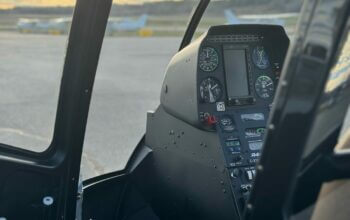An Australian Transport Safety Bureau (ATSB) safety advisory notice urges Robinson helicopter pilots to avoid mechanical turbulence wherever possible, and to reduce airspeed where it is unavoidable.
The safety advisory notice comes as the ATSB continues its investigation into an in-flight break-up at Hawks Nest, New South Wales, where a pilot was fatally injured when their R66 broke up in flight after flying over Yacaaba Headland on Oct. 26, 2023.
In January 2024 the ATSB provided its preliminary report detailing information gathered during the early evidence collection phase of its transport safety investigation.
The safety advisory notice further details that prior to encountering turbulence, the helicopter was traveling at an airspeed which may have increased the severity of the aerodynamic effects of the turbulence.
This possibly reduced the time available for the pilot to recognize and recover from a low-g condition, and to avoid a loss of control.
“While the investigation is ongoing, the circumstances as known at this time suggest the helicopter encountered turbulence followed by a low-g condition immediately prior to the in-flight break-up,” chief commissioner Angus Mitchell said.
“While we continue to determine the factors that contributed to this tragic accident, we feel it is prudent to highlight the manufacturer’s advice regarding flight in turbulent conditions, and avoidance/recovery from low-g flight.”
Handling conditions of Robinson helicopters in low-g and turbulent conditions are documented and detailed in the manufacturer’s Safety Notices SN-11 and SN-32, respectively.
“In both cases an increased airspeed affects the severity of the resulting aircraft response, and increases the likelihood of mast bumping and in-flight break-up,” Mitchell said.
SN-32 advises pilots to reduce airspeed to 60 – 70 kt if significant turbulence is encountered.
SN-11 discusses low-g (weightless) conditions, and the response to correct the powerful right roll known to occur as a result.
In such circumstances, it advises, “The rotor must be reloaded before lateral cyclic can stop the right roll. To reload the rotor, apply an immediate gentle aft cyclic, but avoid any large aft cyclic inputs.”
“The ATSB reminds pilots to remain vigilant at all times and to continuously assess conditions to identify the possibility for turbulence. Where any doubt exists, pilots should reduce airspeed prior to entering an area with potential for turbulence to reduce the effects of, and increase the available response time to, an upset condition,” Mitchell concluded.
Read the safety advisory notice: Anticipate turbulence and slow down
This press release was prepared and distributed by the Australian Transport Safety Bureau.









